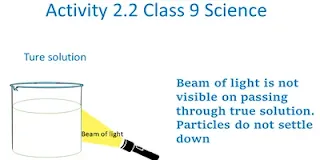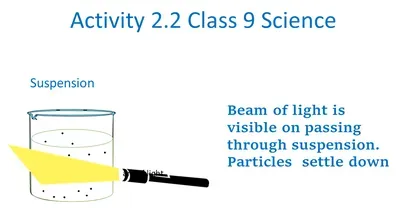In this post, you will find NCERT Science Class 9 Chapter 2 Activity solutions. In Class 9 science chapter 2 Is Matter Around Us Pure consists of NCERT Activity 2.2 Class 9 Science Explanation with a conclusion. Activity 2.1 is also an important activity from an examination point of view.
Activity 2.2 NCERT Class9 Science Is Matter Around Us Pure
You are
suggested to study NCERT activity 2.2 class 9 science Is matter around us pure
explanation with a conclusion so that you can attempt questions based on the
activity 2.2 class 9 science. Activity 2.2 class 10 science will be very useful
for you.
Activity 2.2 Class 9 Science
· Let us again divide the class into four groups- A, B, C, and D
· Distribute the following samples to each group:
-
Few crystals of copper sulphate to group A
-
One spatula full of copper sulphate to group B
-
Chalk powder or wheat flour to group C
- Few drops of milk or ink to group D
· Each group should add the given sample to water and stir the property using a glass rod. Are the particles in the mixture visible?
· Direct a beam of light from a torch through the beaker containing the mixture and observe from the front. Was the path of the beam of light visible?
· Leave the mixture undisturbed for a few minutes (and set up the filtration apparatus in the meantime). Is the mixture stable or do the particles begin to settle do the particles begin to settle after some time?
· Filter the mixture. Is there any residue on the filter paper? Discuss the results and form an opinion.
· Group A and B have got a solution.
· Group C has got a suspension.
· Group D has got a colloidal solution.
Observation
We observe
that both groups A and B have got the true solution. In the case of the solution
obtained by group A, the intensity of the blue colour containing a few crystals
of copper sulphate is comparatively lower than that of the solution obtained by
group B which contains one spatula full of copper sulphate.
i.
In both groups, true solutions are obtained and particles are not
visible to the naked eye.
ii.
When a beam of light is directed through both beakers, the path of light
is not visible.
iii.
Particles of solutions do not settle down when left undisturbed for some
time.
iv.
The whole solution passed through filter paper and there is no residue
left on the filter paper.
 |
| true solution |
For group, C Chalk powder or wheat flour is added to water, and a suspension is obtained.
i.
the particles of solute are visible to the naked eye.
ii.
When a beam of light is directed through the beakers, particles scatter
the light so the path of light is visible.
iii.
Particles settle down when left undisturbed for some time.
iv.
Particles of solute remained as a residue on the filter paper.
 |
| suspension |
For group
D, milk or ink is added to water, and a colloidal solution is obtained.
i.
The particles of colloidal solution are not visible to naked eyes.
ii.
When a beam of light is passed through it, particles scatter the light
so the path of light is visible.
iii.
Particles do not settle down when left undisturbed for some time.
iv.
Colloidal solution passes through the filter paper and no residue is
left on the filter paper.
.webp) |
| Colloidal solution |
Conclusion
Through this activity, we can find the
properties and nature of the true solution, suspension and colloidal solution.
These properties depend on the size of
particles.
Related Topics for you
1. Next Activity - Activity 2.3 Class 9 Science
2. Previous Activity - Activity 2.1 Class 9 Science
3. Solutions of Chapter 2 Is Matter Around Us Pure

.webp)

